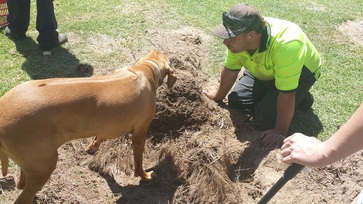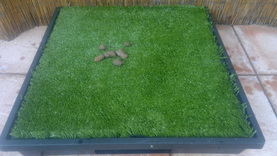
1. Your dog doesn't know the difference between a trick and any other training task. To your dog, “sit” and “stay” are no more important than “shake hands”. So teaching tricks gives your dog more practice in how to learn. It makes teaching the important tasks easier due to this history.
2. If it makes learning easier for the dog, it also makes the trainer a better teacher simply by providing more practice in training the dog. Hopefully practice improves technique and creates more efficient results.
3. The really neat thing is that when people train tricks they are usually happier and less stressed than when they are teaching the important tasks. Think, “stay” on your bed while we are eating and stop jumping on us. How frustrating can that be? Or to stop pulling on lead? Compare this to "roll over" or "speak". When the teacher thinks it’s fun, it’s more fun for the dog. A relaxed, calm teacher who is smiling and patient is so much nicer to learn from than the frustrated, “you have to learn it now because it is very important” instructor.
4. Time spent training tricks is invaluable time to create a connection between human and dog. If this time is positive and rewarding for both participants, this is an investment in a positive relationship. The same is true of time spent frustrated or resorting to punishing techniques. This depletes the relationship bank balance.
5. Training tricks stimulates the dog’s mind and is one way to provide stimulation. It’s part of providing an enriching environment for the dog and reducing problem behaviours that result from boredom. Dogs who are satiated don’t have such a pressing need to amuse themselves.
6. Dogs who can’t exercise due to illness, poor exercise tolerance or anxiety benefit greatly from the time spent teaching tricks. It fills a void and can be a way of providing carefully monitored and safe exercise.
7. I've saved my favourite for last. Teaching tricks using positive reinforcement can open up a wonderful world of communication between the guardian and the dog. Communication the dog is empowered to initiate.
I emphasize the way training takes place because using techniques involving aversive stimulation, which are unpleasant things, results in avoidance or escape. They seldom lead to increased motivation to interact. Dogs will usually only do the minimum required to escape punishment or avoid pressure. In contrast, dogs taught with positive reinforcement of desired behaviours tend to continue to offer behaviours with increased vigour compared to just offering enough to remove pressure and bring back the status quo.
Communication is a two-way street. It requires interaction between both parties. That’s why a dog who has learnt to interact with fun methods and then chooses to interact spontaneously is well on the way to communicating.
Zuri has shown me how teaching simple tricks can morph into a language where she conveys her wants or needs at a particular time.
“Get yah collar” Trick:
I’ve taught Zuri to find and retrieve her collar for me when I say, “Find collar.” I hide it in various places and ask her to find it and bring it to me. This became very handy. I could ask her to, “Find collar” before we went for walks or went outside. Then a very poignant moment occurred.
I was sitting at the computer working away. Zuri came and sat behind me. Every now and again she would give a soft whine.
“Yeh, hang on. We can go out soon.”
An hour later she was still patiently waiting. Then I heard the sound of something dropping behind me. I turned. Zuri had gone searching, found her collar and dropped it behind my chair. Wow. When one way of asking to go go outside didn't work, she problem solved and predicted the outcome of finding and bringing me the collar: I would put it on and take her outside. That’s exactly what I did immediately! I wanted to reinforce her ingenuity.
It doesn’t stop there. Zuri now uses the collar to let me know when she wants to go out the front at various times of the day. When she wakes up, she goes to get her collar wherever it is and brings it to me so I can let her out the front to sun bake. It doesn't matter where I am either. I can still be in bed or in the kitchen. Most recently she was waiting outside the bathroom. The collar can be lying around in full view but she only brings it to me when she wants to go out the front. Pretty neat communication huh?

“Trade an empty for a full one” trick:
I feed Zuri her usual meals by stuffing Kongs. I’ve taught her the trick of bringing me the empty Kong and I will trade it for a full one. Did I mention that tricks can be useful and save leg work and searching for toys too? I usually give Zuri four Kongs. Have you ever wondered what your dog would do if presented with an all-you-can-eat buffet? What if I had a never ending supply of trade Kongs? Would she just keep bringing the empty one back for the full one - until she exploded? The trade trick became a means of communicating how hungry she was. The number of times she brought the Kong back for more was between two and six. It varied depending on the day. When she has had enough, she doesn't bring me the empty Kong. I was particularly impressed with the time she only wanted three Kongs, since I originally suspected I may have conditioned her to expect four simply because of routine. I was particularly relieved that she only wanted seven on one occasion.
So this is why I feel tricks play an important role, not only in enriching the dog's life, but also enriching the relationship between dog and guardian.
Have you been surprised at how a trick spontaneously turned into a way for your dog to let you know his/her needs?










































 RSS Feed
RSS Feed